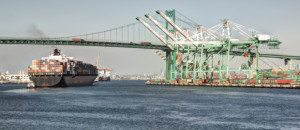 Negotiations were scheduled to expire soon for a new contract agreement covering nearly 14,000 dockworkers at 30 ports stretching from San Diego, Calif., to Bellingham, Wash., and a new study claims the nation’s economy could take as much as a $2.5 billion hit each day of a prolonged West Coast port strike.
Negotiations were scheduled to expire soon for a new contract agreement covering nearly 14,000 dockworkers at 30 ports stretching from San Diego, Calif., to Bellingham, Wash., and a new study claims the nation’s economy could take as much as a $2.5 billion hit each day of a prolonged West Coast port strike.
The study — conducted by the National Association of Manufacturers (NAM) and the National Retail Federation (NRF) by economists at the Interindustry Forecasting Project at the University of Maryland — said the economic blowback of any extended strike would grow with time.
“A protracted dispute between the negotiating parties could lead to reduced or shuttered terminal operations for an extended period,” the study concluded. “If such disruptions occur, the economic impact would be significant and widespread.”
The report said a five-day stoppage would:
- Reduce GDP $1.9 billion a day
- Disrupt 73,000 jobs
- Cost the average household $81 in purchasing power.
- A 10-day stoppage would:
- Reduce GDP $2.1 billion a day
- Disrupt 169,000 jobs
- Cost the average household $170 in purchasing power.
A 20-day stoppage would:
- Reduce GDP $2.5 billion a day
- Disrupt 405,000 jobs
- Cost the average household $366 in purchasing power.
“It is important for the parties at the table as well as others to fully understand the economic consequences of a port disruption,” said Matthew Shay, president and CEO of NRF. “Any supply chain disruption, whether it’s a port slowdown or outright stoppage, would cripple international trade, stymie supply chains and hurt domestic employment and consumer spending. For retailers and their customers, a port closure would mean a delay in back-to-school and holiday shipments that could significantly drive up consumer prices.”
NAM President and CEO Jay Timmons stated, “Manufacturers depend on the ability of West Coast ports to efficiently move cargo valued at 12.5 percent of U.S. GDP. A shutdown would erode that figure and inflict long-term damage to our competitiveness as manufacturers and as a nation. The parties must come to an agreement before the current contract expires.”
The last major West Coast port disruption occurred in 2002, when management locked out dockworkers for 10 days until then-President George W. Bush ordered the two sides back to work under the Taft-Hartley Act. That shutdown was estimated to cost the U.S. economy several billion dollars.
The port strike couldn’t have come at a worse time. The industry has been recovering from one of the worst winters on record and we’re just now seeing big time numbers across the boards. If the port strike continues, it could really cost our economy.







